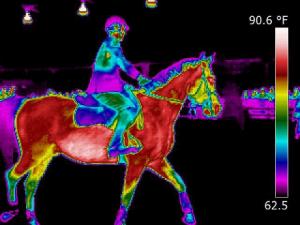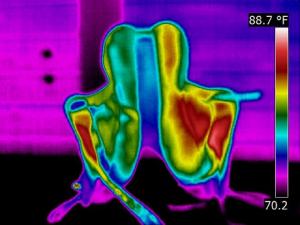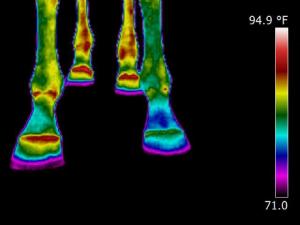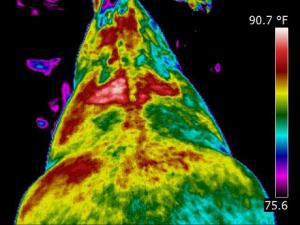By Leigh Ballard
Equine thermography is becoming an increasingly useful tool to help diagnose horse health problems. The thermography process utilizes an extremely sensitive infrared camera to give a picture of the animal’s heat being radiated from the body, indicating circulation patterns. Infrared scans are completely non-invasive, emit no radiation, and do not require any sedation for the horse. Infrared scans often eliminate the need for expensive investigations to locate the source of problems.
Heat patterns should appear symmetrical, so any abnormality or anomaly in the pattern is likely a source of a problem. Infrared scans of a horse can pinpoint areas of concern, either hot spots or cold spots, that may indicate increased or decreased circulation in the limbs or other areas of the body. Increased circulation typically indicates inflammation, and cold spots may be indicators of lack of circulation, i.e. nerve damage or muscle atrophy.
The camera shows physiological changes (circulation) that occur in response to underlying anatomical problems (bone fracture, tendon tear), but does not diagnose the specific problem. An infrared camera is a tool to direct veterinarians to sources of a problem. The camera does not see anatomical structures like bones and tendons. It does, however, indicate inflammation radiating from anatomical structures. The camera cannot diagnose a specific problem, like a fracture, but it can guide the practitioner to the area that needs further evaluation and treatment.
Dr. Tracy Turner has been instrumental in developing the thermal imaging technology for use in performance horses. In his research at racetracks, he determined that horses could be kept sound by monitoring their tendons and joints while in training. The camera can find developing problems up to three weeks before a horse shows any clinical signs of pain. Abnormal thermal patterns can predict injury, and knowing about these at an early stage can help avoid injury, keeping a horse sound. Some training barns have adopted the use of infrared scans as a preventative measure, and utilize them in their wellness programs for their horses in training.
Thermography is also useful in monitoring the healing process of injuries. Often a horse’s pain will ease and he might appear to have recovered from injury, only to return to work too soon. The camera can be use to watch an injury site until all inflammation is gone, helping prevent re-injury to the site.
Infrared scans are especially useful in determining the source of a difficult to diagnose “mystery lameness.” Horses can’t tell us where something hurts. Since horses evolved from prey animals, for many their instinct is to mask pain, so the owner and the veterinarian might be perplexed as to the reason for the lameness. There is often a trial and error treatment program for vague problems that don’t show clear signs of the source of lameness. Instead of spending much time and money on diagnostics and treatments, like blocking or multiple radiographs (x-rays) that don’t solve the problem, the infrared camera can usually find the source of lameness by showing inflammation. The camera used in detecting such problems is 40 times more sensitive to heat than a human hand, so it can indicate inflammation that can’t be detected with traditional palpation.
Thermography is a useful tool for determining saddle fit. The saddle is placed on the horse for a few minutes while it warms up. Then the thermal patterns on the underside of the saddle are examined to determine proper contact with the horse’s back. A scan of the horse’s back can also give an indication of saddle fit. Areas of inflammation can be clearly seen where a saddle might be pinching and causing pain to the horse. Poor saddle fit can cause back problems. Dr. Turner says, “Back problems are a significant cause of altered gait, poor performance, and misbehavior in the horse, particularly in English disciplines. The complexity of the back, its vertebrae, ligaments, and muscles can make diagnosing, imaging, and treating back problems very challenging. Musculoskeletal issues of other regions, particularly the hind limbs, can create secondary back issues.” Sometimes, a horse’s negative behaviors under saddle, like bucking, rearing or pinning ears, can be “cured” by proper saddle fit.
Likewise, rider balance can be checked with thermography. As in the saddle fit examination, the underside of the saddle is examined for heat patterns that show a rider’s weight distribution. Potentially, a rider’s seat and position can be improved with information gained from a thermal scan.
In his extensive work with thermography, Dr. Turner has researched the back problem known as “kissing spines,” which can significantly affect performance, especially in dressage horses. He thinks dressage horses are more prone to this problem because they engage their hind ends, the rider sits more, and they are more compressed than in other disciplines. Also, dressage riders are highly tuned to their horse’s movement and might notice an “off” gait more than other riders. Thermography can detect the location of a probable “kissing spines” problem, which then should be further explored with radiography.
Thermography has its uses in hoof care also. Farriers can use the tool to determine hoof balance and show how the horse is bearing weight. Abscesses are easy to locate. Navicular changes and evidence of laminitis are also detectable by thermal scans.
Infrared cameras are also used in horse ethics situations. Dr. Turner headed a study using thermal imaging to assess compliance with the Horse Protection Act (HPA) in the Tennessee Walking Horse industry. (Mid-south veterinarian Dr. Mark Akin was a part of the team for this study.) The Federation Equestre Internationale (FEI) has recently instituted thermal imaging to detect hypersensitizing the legs of high-level show jumpers.
Pre-purchase scans of horses can be valuable for detecting undisclosed problems. Areas of concern can be identified for further vetting.
More information about equine thermography can be found at the American Association of Equine Practioner’s (AAEP) website: www.thehorse.com. Many of Dr. Tracy Turner’s research articles can be found there, and were used extensively for this article.
Equine thermography is becoming an increasingly useful tool to help diagnose horse health problems. The thermography process utilizes an extremely sensitive infrared camera to give a picture of the animal’s heat being radiated from the body, indicating circulation patterns. Infrared scans are completely non-invasive, emit no radiation, and do not require any sedation for the horse. Infrared scans often eliminate the need for expensive investigations to locate the source of problems.
Heat patterns should appear symmetrical, so any abnormality or anomaly in the pattern is likely a source of a problem. Infrared scans of a horse can pinpoint areas of concern, either hot spots or cold spots, that may indicate increased or decreased circulation in the limbs or other areas of the body. Increased circulation typically indicates inflammation, and cold spots may be indicators of lack of circulation, i.e. nerve damage or muscle atrophy.
The camera shows physiological changes (circulation) that occur in response to underlying anatomical problems (bone fracture, tendon tear), but does not diagnose the specific problem. An infrared camera is a tool to direct veterinarians to sources of a problem. The camera does not see anatomical structures like bones and tendons. It does, however, indicate inflammation radiating from anatomical structures. The camera cannot diagnose a specific problem, like a fracture, but it can guide the practitioner to the area that needs further evaluation and treatment.
Dr. Tracy Turner has been instrumental in developing the thermal imaging technology for use in performance horses. In his research at racetracks, he determined that horses could be kept sound by monitoring their tendons and joints while in training. The camera can find developing problems up to three weeks before a horse shows any clinical signs of pain. Abnormal thermal patterns can predict injury, and knowing about these at an early stage can help avoid injury, keeping a horse sound. Some training barns have adopted the use of infrared scans as a preventative measure, and utilize them in their wellness programs for their horses in training.
Thermography is also useful in monitoring the healing process of injuries. Often a horse’s pain will ease and he might appear to have recovered from injury, only to return to work too soon. The camera can be use to watch an injury site until all inflammation is gone, helping prevent re-injury to the site.
Infrared scans are especially useful in determining the source of a difficult to diagnose “mystery lameness.” Horses can’t tell us where something hurts. Since horses evolved from prey animals, for many their instinct is to mask pain, so the owner and the veterinarian might be perplexed as to the reason for the lameness. There is often a trial and error treatment program for vague problems that don’t show clear signs of the source of lameness. Instead of spending much time and money on diagnostics and treatments, like blocking or multiple radiographs (x-rays) that don’t solve the problem, the infrared camera can usually find the source of lameness by showing inflammation. The camera used in detecting such problems is 40 times more sensitive to heat than a human hand, so it can indicate inflammation that can’t be detected with traditional palpation.
Thermography is a useful tool for determining saddle fit. The saddle is placed on the horse for a few minutes while it warms up. Then the thermal patterns on the underside of the saddle are examined to determine proper contact with the horse’s back. A scan of the horse’s back can also give an indication of saddle fit. Areas of inflammation can be clearly seen where a saddle might be pinching and causing pain to the horse. Poor saddle fit can cause back problems. Dr. Turner says, “Back problems are a significant cause of altered gait, poor performance, and misbehavior in the horse, particularly in English disciplines. The complexity of the back, its vertebrae, ligaments, and muscles can make diagnosing, imaging, and treating back problems very challenging. Musculoskeletal issues of other regions, particularly the hind limbs, can create secondary back issues.” Sometimes, a horse’s negative behaviors under saddle, like bucking, rearing or pinning ears, can be “cured” by proper saddle fit.
Likewise, rider balance can be checked with thermography. As in the saddle fit examination, the underside of the saddle is examined for heat patterns that show a rider’s weight distribution. Potentially, a rider’s seat and position can be improved with information gained from a thermal scan.
In his extensive work with thermography, Dr. Turner has researched the back problem known as “kissing spines,” which can significantly affect performance, especially in dressage horses. He thinks dressage horses are more prone to this problem because they engage their hind ends, the rider sits more, and they are more compressed than in other disciplines. Also, dressage riders are highly tuned to their horse’s movement and might notice an “off” gait more than other riders. Thermography can detect the location of a probable “kissing spines” problem, which then should be further explored with radiography.
Thermography has its uses in hoof care also. Farriers can use the tool to determine hoof balance and show how the horse is bearing weight. Abscesses are easy to locate. Navicular changes and evidence of laminitis are also detectable by thermal scans.
Infrared cameras are also used in horse ethics situations. Dr. Turner headed a study using thermal imaging to assess compliance with the Horse Protection Act (HPA) in the Tennessee Walking Horse industry. (Mid-south veterinarian Dr. Mark Akin was a part of the team for this study.) The Federation Equestre Internationale (FEI) has recently instituted thermal imaging to detect hypersensitizing the legs of high-level show jumpers.
Pre-purchase scans of horses can be valuable for detecting undisclosed problems. Areas of concern can be identified for further vetting.
More information about equine thermography can be found at the American Association of Equine Practioner’s (AAEP) website: www.thehorse.com. Many of Dr. Tracy Turner’s research articles can be found there, and were used extensively for this article.











